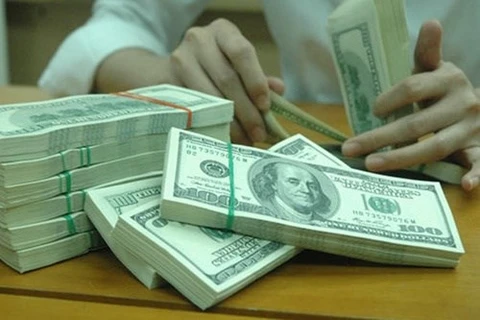Hanoi (VNA) – Contrary to 2016, credit growth expanded fast in the first half of 2017 while mobilised capital dropped, leading to a wide gap between the two sources.
However, the slow disbursement of public investment helped increase the State Treasury’s deposits in commercial banks, reducing pressure on interest rates.
The assessment was made by Dr. Nguyen Duc Thanh, Director of the Vietnam Institute for Economic and Policy Research (VEPR) at a ceremony in Hanoi on July 10 to announce VEPR’s macro-economy report for the second quarter of 2017.
According to VEPR, by June 20, 2017, credit growth reached 7.54 percent compared to that in December last year, the highest figure recorded in the past six years. Particularly, credit saw the fastest growth pace in the second quarter, showing the Government’s determination to fulfill the set growth target.
Meanwhile, deposit growth slumped compared to the same period of 2016, reaching only 5.89 percent. However, interest rates in the interbank market still fell strongly in the second quarter. The overnight rate dropped 3.24 percentage points compared to the previous quarter to 1.47 percent averagely in June 2017, while the weekly interest rate also plummeted to 1.84 percent.
The State Treasury’s deposits in the banking system are considered a main reason behind the high liquidity in the market, according to VEPR.
The latest report of the National Committee on Financial Supervision showed that the State Treasury’s deposits in banks by the end of April reached 122 trillion VND (around 5.37 billion USD), a rise of 28.4 percent compared to the beginning of this year. This also reflected slow disbursement of public investment, said the report.
At the same time, deposit interest rates remained stable with only slight rises in some long-term deposits in big commercial banks, maintaining at 6.4-7.2 percent. Interest rates for middle-term and short-term were from 4.5-5.4 percent and 5.4-6.5 percent per year, respectively.
These conditions and the low inflation prompted the State Bank of Vietnam to cut prime interest rate by 0.25 percentage points and lower the ceiling lending interest rate by 0.5 percentage points. The move is expected to help interest rates drop further in the coming time, according to the report.
VEPR experts held that this is a proper decision that facilitates the development of businesses.
However, Dr. Nguyen Duc Thanh noted that the fast expansion of money supply led to a high M2/GDP ratio, standing at 146 percent, while the figures were 80 percent in 2006 and 114 percent in 2010.
He also warned of higher inflation in the coming time when the loosing currency policy affects the economy.-VNA
However, the slow disbursement of public investment helped increase the State Treasury’s deposits in commercial banks, reducing pressure on interest rates.
The assessment was made by Dr. Nguyen Duc Thanh, Director of the Vietnam Institute for Economic and Policy Research (VEPR) at a ceremony in Hanoi on July 10 to announce VEPR’s macro-economy report for the second quarter of 2017.
According to VEPR, by June 20, 2017, credit growth reached 7.54 percent compared to that in December last year, the highest figure recorded in the past six years. Particularly, credit saw the fastest growth pace in the second quarter, showing the Government’s determination to fulfill the set growth target.
Meanwhile, deposit growth slumped compared to the same period of 2016, reaching only 5.89 percent. However, interest rates in the interbank market still fell strongly in the second quarter. The overnight rate dropped 3.24 percentage points compared to the previous quarter to 1.47 percent averagely in June 2017, while the weekly interest rate also plummeted to 1.84 percent.
The State Treasury’s deposits in the banking system are considered a main reason behind the high liquidity in the market, according to VEPR.
The latest report of the National Committee on Financial Supervision showed that the State Treasury’s deposits in banks by the end of April reached 122 trillion VND (around 5.37 billion USD), a rise of 28.4 percent compared to the beginning of this year. This also reflected slow disbursement of public investment, said the report.
At the same time, deposit interest rates remained stable with only slight rises in some long-term deposits in big commercial banks, maintaining at 6.4-7.2 percent. Interest rates for middle-term and short-term were from 4.5-5.4 percent and 5.4-6.5 percent per year, respectively.
These conditions and the low inflation prompted the State Bank of Vietnam to cut prime interest rate by 0.25 percentage points and lower the ceiling lending interest rate by 0.5 percentage points. The move is expected to help interest rates drop further in the coming time, according to the report.
VEPR experts held that this is a proper decision that facilitates the development of businesses.
However, Dr. Nguyen Duc Thanh noted that the fast expansion of money supply led to a high M2/GDP ratio, standing at 146 percent, while the figures were 80 percent in 2006 and 114 percent in 2010.
He also warned of higher inflation in the coming time when the loosing currency policy affects the economy.-VNA
VNA

























